Arayes, Stuffed Pita Sandwiches of the Levant
Arayes, confidently states many an internet recipe, are a Lebanese sandwich made of kofta kebab meat spread inside a pita and grilled, generally served as a hot mezze or appetizer. Many other sources–a smaller number, yes, but still significant–claim it to be of Palestinian origin. Some say it comes from Galilee in Israel but based on the number of Lifestyle articles featuring it as a “new craze” in mainstream Israeli culture over the past 3 years, I hesitate to ascribe to it that origin.
Still others call it a Syrian delicacy, with one extremely confident and caucasian mommy blogger asserting that it was invented by and named after a “legendary Syrian chef” named Salah al-Din Abu Rayyas in either the 12th, 13th, or 15th Century. Of course this word-salad post (click at risk of your own sanity), which reads like it was copied and pasted from at least 5 different sources and run back and forth through machine translation a few times, is full of dubious claims, like “it should be leaner than most meats so that it doesn’t dry out when cooking” (most cooks, I believe, would advise to use a fattier meat to avoid dryness). It also gives 3 additional origins for the name “arayes,” which is variably claimed to come from Arabic words for “to grill,” “to be roasted,” or “roasted meat pie.” (The other sources I’ve seen, as well as Google Translate, seem to agree instead that it comes from a word meaning “bride.”)
Regardless of origin, you can order it at many a Middle-Eastern restaurant, including a favorite of mine, Al Bawadi Grill in Bridgeview IL, which serves “traditional cuisine native to Palestine, Jordan, Lebanon and Syria” according to a 2020 Chicago Tribune article about their second location in Niles. There does appear to be quite a bit of crossover between the various Levantine cuisines. Mindy and I ate there recently with our youngest son, trying both their meat and cheese arayes along with some other favorites like shawarma, shish tawook, muthawama (an absolute favorite of mine, similar to Greek skordalia), fattoush salad, and their spectacular dessert kenafeh.
In a lineup of dishes like that, the thinly-filled arayes served by Al Bawadi are unlikely to be the star, and these did not exceed my expectations in that way. But they do make a good addition to a spread, especially one including dips or pickles that can be scooped up with the stuffed flatbreads.
That area of Bridgeview around 87th and Harlem though is rich with Middle-Eastern markets and restaurants, sweet shops and bakeries, including my favorite place to get pitas, Alwatan.
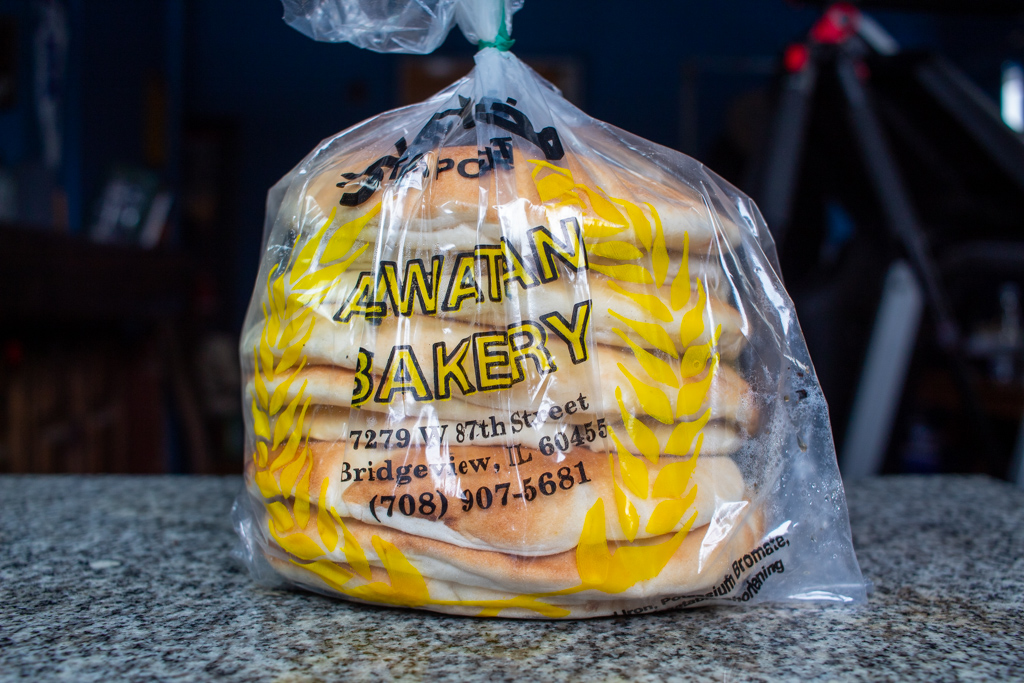
Kofta and arayes both, like many things, vary greatly from recipe to recipe. And as is my habit, I read many of them, picked out the commonalities (ground beef or lamb, plenty of onion, garlic, and parsley) and my preferred flourishes (sumac, a Middle Eastern chili paste called shatta, pomegranate molasses, dried mint leaves) and made my best approximation of what should be my ideal kofta or arayes filling.
If I had succeeded, I would share that recipe with you. I did not succeed. It was not terrible, but the combination of the shatta and the pomegranate molasses was too much. I should have stuck with a much more basic recipe. Not all those flavors needed to be together.

To make the arayes, I cut some of these pocket-style pitas in half, opening the interior to create a reservoir for the filling, then cutting them in half again to make wedge shapes.
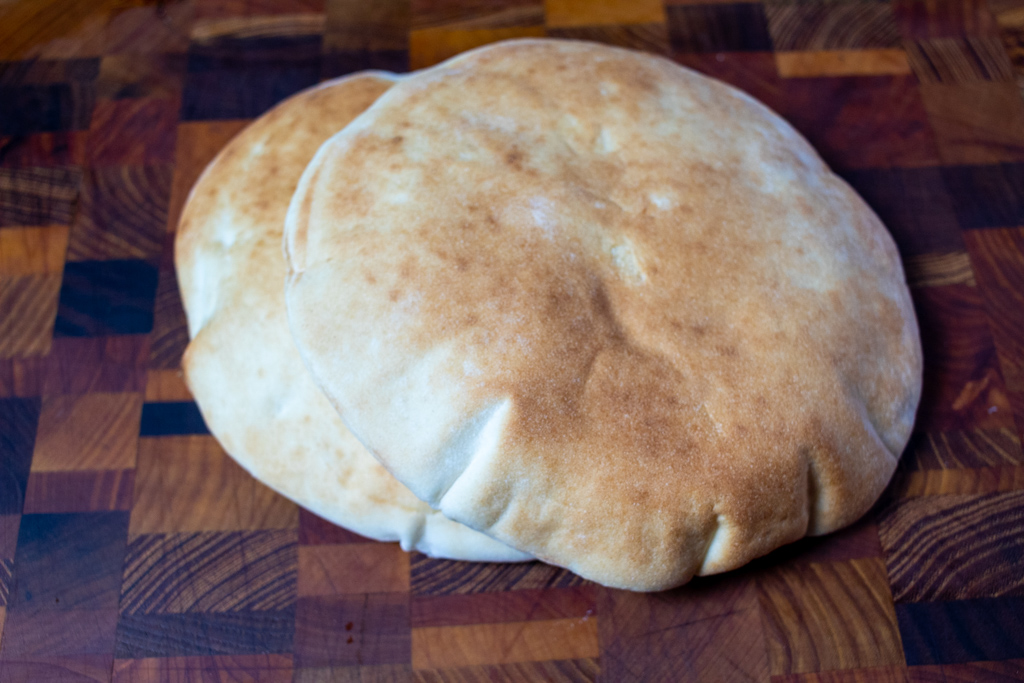
These I filled with the meat mixture, just a bit more thickly than what we’d had at Al Bawadi.

I also made cheese-filled arayes, picking up some Akawi cheese, from the market next door to Alwatan. This akawi is a fresh cow’s-milk cheese, salty from brining, with a “squeakiness” like fresh Wisconsin curds and a tendency to retain its shape when heated rather than melt.

It may seem counterintuitive to use a non-melting cheese for what is essentially a grilled cheese sandwich. It also may not make much sense to then shred it before stuffing it into open wedges of split pita.


There is a method to this madness though, or at least I like to think my reasoning was sound. A meltier cheese would be more likely to ooze out the sides and drip out onto the cooking surface–whether an oven pan, a panini press, or the grates of a charcoal grill. This I thought would stay in place better. And I shredded it because it would otherwise be more difficult to fit into the quarter-circle wedges of pita I’d cut.
A note on cooking: I mentioned several different methods, and various recipes call for different options. They can be baked or broiled, griddled or pressed. I chose, in January, to light a charcoal fire and cook them outside on my mini-grill.



The bread, brushed with olive oil, began to char almost immediately on the hotter spots of the grill, while other spots barely gave their arayes any color at all. Flipping one of these within 30-45 seconds of having placed it on the grill, and then removing it entirely within 2 minutes, hardly gave these arayes time to cook the meat through, so I finished them in a pan in the oven.
The flavors of this kofta mixture were recognizable to a fan of Mediterranean cuisine–that parsley/onion/sumac mixture is classic for a reason, the lemony sumac brightening the pungency of the onion, with the earthiness of the parsley helping to calm the bite. Here though we had the sweet, tart, and even slightly bitter pomegranate clamoring for attention, with the shatta adding a flavor every bit as sour as it was spicy. Even with the additional cooling influence of the mint, it was too much, and that’s on me for Frankensteining a recipe instead of just finding a single voice I could trust in the sea of SEO-optimized recipe posts and following that siren.
The cheese arayes were more successfull–akawi is a great cheese, milky like a fresh mozzarella but saltier, soft from the heat yet springy, with a squeak and a snap to it. It won’t win any cheese-pull competitions but it’s no strange to a grill, and it worked nicely in these pitas that might not have been “burnt to a crisp” as Mindy described them, but had a healthy amount of char.


Neither of these could be described as an unqualified success. However I had, in my planning, given myself one more chance to succeed, with an arayes filling that was not necessarily traditional but should be familiar to anyone from a culture that eats arayes.

This is a type of Levantine baked good called a Fatayer. It is essentially pita or a similar leavened dough rolled out flat, stuffed with a filling, folded over, and baked. A hand pie, I suppose you’d call it, and this example, from the aforementioned Alwatan Bakery, is my favorite, made with a spicy and sour spinach filling.
Now, Bridgeview is a whole 2 exits northwest of me on the expressway, a good 15-20 minute drive, and these spicy spinach fatayer sometimes sell out quickly. (Though other days I have been able to pick them up in the mid-afternoon. It is unpredictable.)
Wouldn’t it be nice if I could just make that spinach filling myself and put it into whatever bread I happened to have on hand? Which, today, happened to be pita that I had also bought from the selfsame bakery that makes these fatayer?
Perhaps not. But I decided to try it anyway, adding an egg to help bind the spinach mixture and keep it inside the pita wedges, and feta cheese simply because it’s delicious. This one you get a recipe for.
Spinach and Feta Arayes
Ingredients
- 2 tbsp olive oil plus additional for brushing
- 1 red onion small
- 12 ounces frozen spinach
- 1 tsp salt
- 1 tsp black pepper
- 1 1/2 tsp dried parsley
- 1 tbsp sumac
- 1/2 lemon
- 1 tsp shatta
- 8 oz feta cheese crumbled
- 1 egg beaten
- 3 pitas
Instructions
- Thaw the spinach, then drain it in a sieve and squeeze out most of the moisture with your hands
- Dice the onion finely
- Add 2 tbsp olive oil to a medium heat pan and sautee the onions until soft and starting to color, 10 minutes
- Add the onion mixture to a bowl with the cold, drained spinach. Add the salt, pepper, parsley, sumac, lemon juice, and shatta chili paste. Mix thoroughly.
- Add the feta crumbles and beaten egg and mix again.
- Cut each pita in half and carefully open to reveal the pocket. Cut in half again to create 12 open wedges.
- Fill each wedge with a half-inch or so layer of the spinach mixture, squeezing to spread evenly and patting into the edges with fingers to avoid filling spilling.
- Brush each pita wedge with olive oil, top and bottom.
- Bake at 350° F for 20 minutes, flipping each wedge once halfway through. Serve hot.
Notes
I baked these instead of grilling them to avoid the blackened exteriors of some of the previous examples, but I think grilling would still make a very good arayes. But maybe in a time of year other than the dead of winter, when there’s the leisure to really work the grill–I think I just rushed things rather than giving the coals a chance to settle down before trying to cook them.
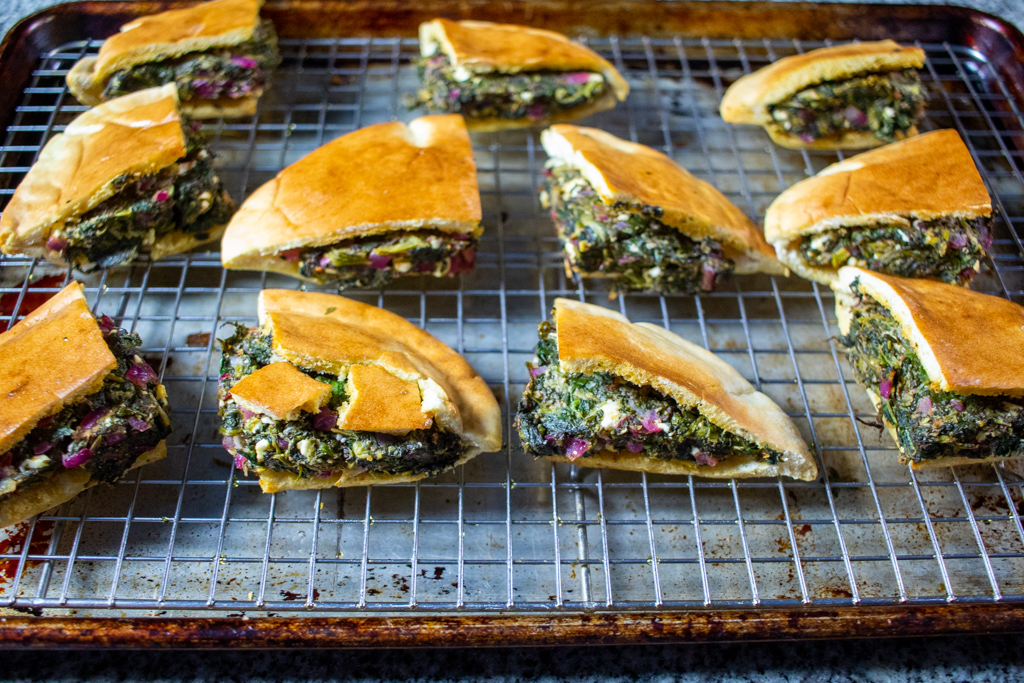
Not only are the outsides less charred, but the filling is nice and colorful.

But flavor is the primary concern, and that is where these excel most of all. I am a fan of spinach–I know not everyone is. But if you enjoy Spanakopita, or spinach-filled burek, or the fatayer I’ve been mentioning, these will appeal to you. The sourness that in Spanakopita is provided by dill comes from the combination of sumac and lemon here, with a spicy boost from the chili paste. These flavors are a natural pairing for the pungent sweetness and slight bitterness of cooked onion and spinach. The briny element provided by the feta helps to amplify each of those other individual components and tie them together.
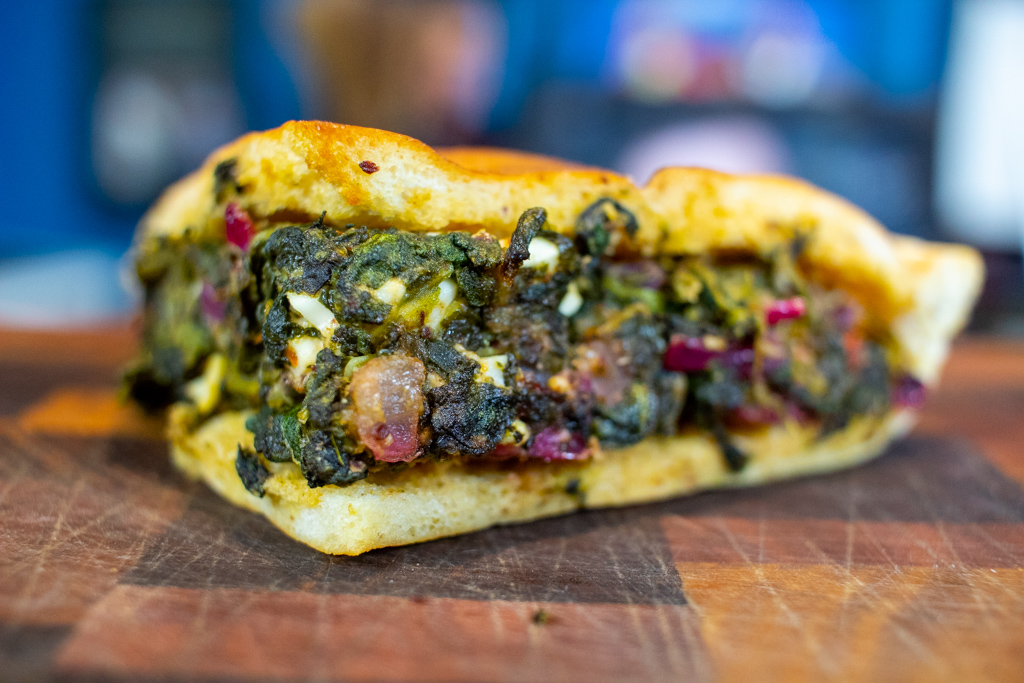
I will try making the meat arayes again–I’ve had koftas that brought me to a standstill, every ounce of my attention focused on that glistening hot and charcoal-scented skewer of minced meat. I feel like a good arayes filling should be similarly transportive. But the spinach arayes recipe is primetime-ready as is.

I like sandwiches.
I like a lot of other things too but sandwiches are pretty great








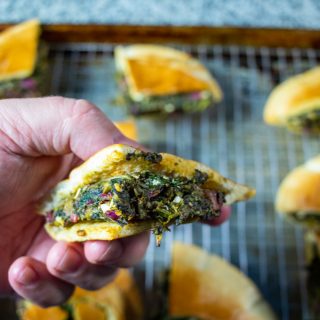
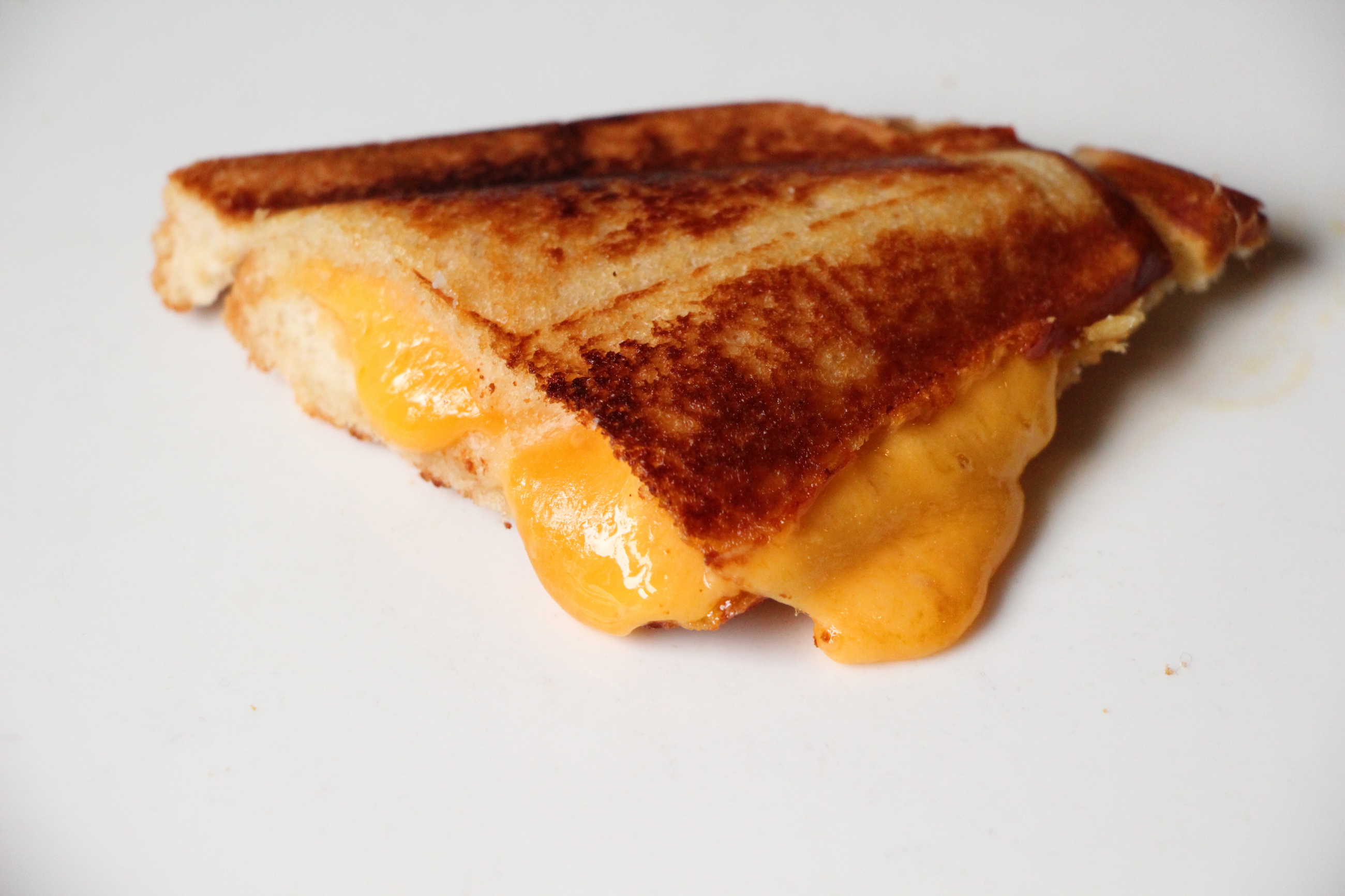


Recent Comments